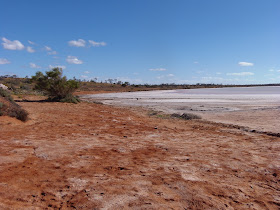At last we made it! A long 1200 km trek from Alice Springs (that includes the 500 km round trip to Ayers Rock). The minute we arrived at Coober Pedy I knew that I would like it. Like Lightning Ridge, this place has characteristics that only an Opal mining Town has. In my opinion, its a sense of "lawlessness" or at least that there are very few rules that apply here other than the general rule of law etc. Or maybe its the "Cowboy" feel that appeals. All that I know is that I am comfortable here. Others had painted a picture of a dangerous or at least unpredictable place but if one is sensible all if fine. Like all Towns, the locals are proud of what they have achieved in setting up in such a harsh environment and rightly so.
There is much to talk about here so this post may be a little longer than usual.
I did mention that "Coober" has a similar feel to "The Ridge" and yet it is unique in it's own way. Maybe a little more structured, or controlled, or planned? Certainly, the underground buildings and homes are not a feature of Lightning Ridge and there is less evidence of actual mining in the Township here. At Lightning Ridge the norm is to find a spot that looks interesting, even if it is near the main street, buy a claim, find or build something to live in and dig a hole looking for Opal. There is one similarity though, Coober is also full of junk, old cars, buses, trucks, mining machinery. It appears that nothing is thrown away. Maybe things where so hard to come by in the past that everything is kept that may be useful at a latter time. Rather than make the place look bad, I reckon it just adds to the charm. The "noodling" fields around the place and the famous underground buildings and houses also add to the atmosphere.
Now some facts. the most important is the origin of the name, Coober Pedy. Now, I thought that it was most likely the name of a pioneer or early Opal miner. Not so, it is fact derived from a word from the Aboriginal, Anangu words "kupa" and "pita" meaning "white man" and "hole in the ground". Well there you go! Until 1920 it was called the Stuart Range Opal Fields when it was renamed Coober Pedy. The first European explorer to reach the area was John Stuart in 1858. The first Opal was discovered in 1915 by a 14 year old Will Hutchison, a member of his father's gold prospecting party. The story goes that Willie strayed from camp, against orders to search for water. When he finally returned he had not only found a waterhole but also showed a sugar bag full of Opal. The first Opal rush didn't occur until 1919, probably because of the remoteness of the place and the lack of water. In 1924 the water issue was partially solved when the Government built a 2 million litre water tank and introduced a water ration of 110 litres per person per week. Today water is pumped 23 kms from a 60 metre deep artesian bore and then is treated using Reverse Osmosis, making it of excellent drinking quality.
Well things developed rapidly, with many European Migrants arriving to make their fortune. Now the town has a population of around 3500 that includes around 45 different nationalities. There is also a sizable Aboriginal community.
The Climate here is harsh to say the least, although it is really pleasant at this time of year. It was around 29 c and dry today. The weather does warm up however with temps from 35c to a whopping 48c in summer! It doesn't rain much either with an average of only 5" or 175mm a year. Consequently, nothing much grows around here, there are no naturally occurring trees in Town, The surrounding country too it treeless and about as desolate as it can be without actually being sandy.The whole area sits on a bed of sand and siltstone 100 feet thick that's topped with a stony desert.















What about the dugouts. "It is said that dugout living began in Coober Pedy when Soldiers returned from the trenches in France in 1918." The temperature in the dugouts varies only about 5 c all year round and remains at around 23 c, very comfortable indeed. Town planning did not exist but that has been rectified with the entire town now having been surveyed and divided up into building blocks and allotments. To construct a dugout one must first buy a piece of land but as all dugouts are excavated from the inside of a natural hill, the block must therefore include at least part of a hill. after designing a layout a contractor is used to excavate the house at a cost of between $20,000 and $120,000, depending on its size. Then plumbing, electrics and "wet areas' are added, the latter near the front so as to dispose of waste by gravity feed. Dividing walls are about 2 metres thick to support the roof, lighting is either natural or artificial and roof vents, that can be seen all around Town and added for ventilation. The cost of a modern underground home today would be about $80,000 to $250,000. Some are very large and luxurious I am told.



That's about it for delightful Coober Pedy, another "Bucket List" entrant for me. For those that want to know something about Opals and Opal mining, I will include another post that deals with that specifically.























































